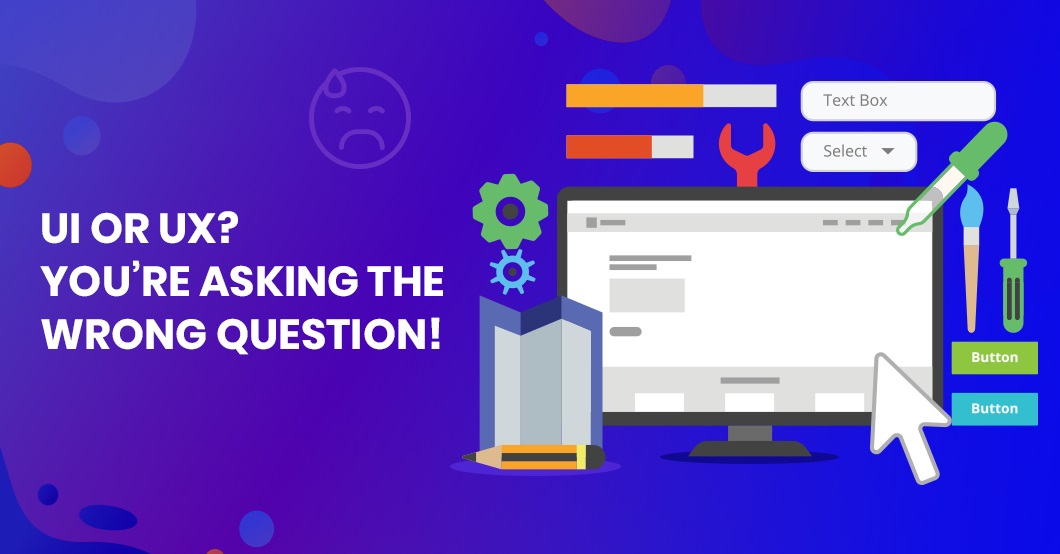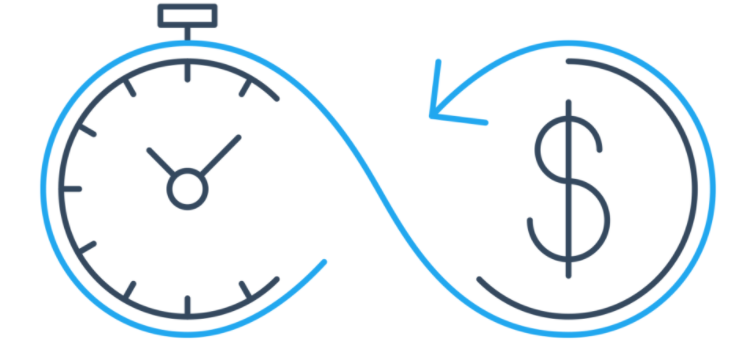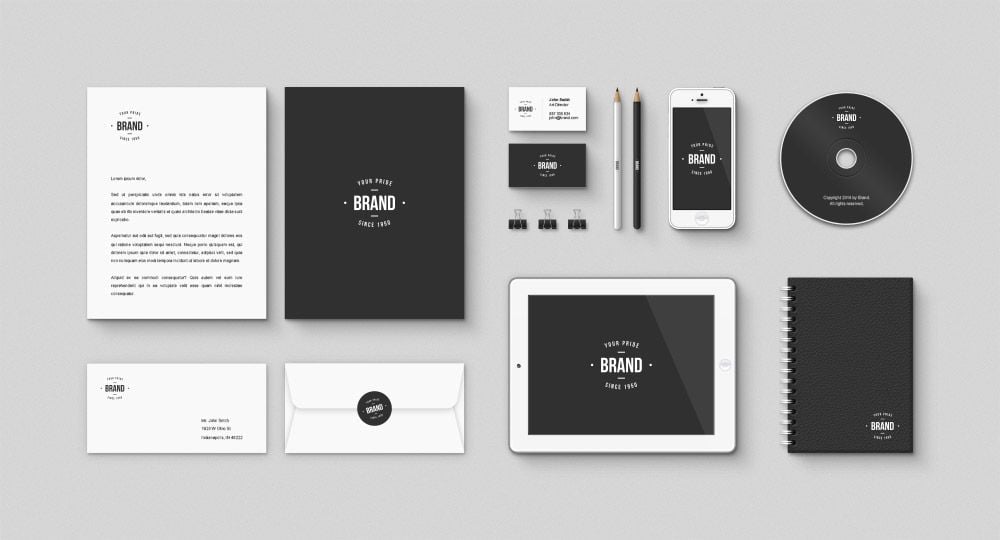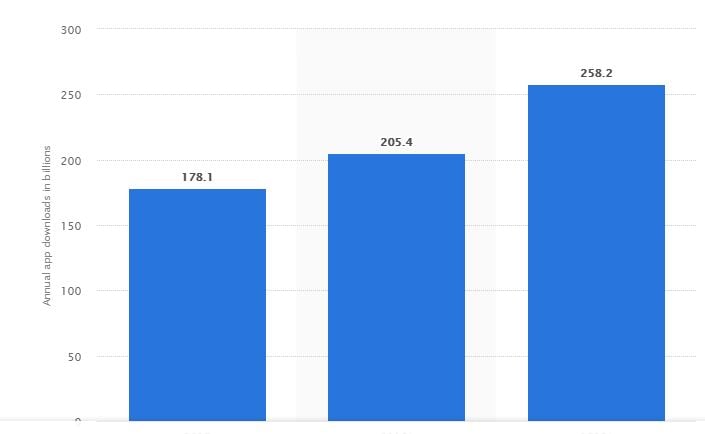
People spend more time-consuming digital media on mobile devices than on a desktop and this trend will continue. Social networking, listening to music, watching videos and playing games represent the bulk of what people do with their smartphones and tablets.
Essentially, it’s about communication and entertainment, two things that help people to cope-up with the level of stress in today’s world.
Thus, the consumption of mobile Apps in the present day continues to grow faster due to the increase in the number of smartphone users across the world.
Certainly, the data that describes the mobile app ecosystem the best is the total app downloads statistics.
Based on a projection, it is estimated that by 2022 the total app downloads number will enhance to a stunning 258.2 billion.
Reputed smartphone and tablet manufacturer, regular hardware updates and introduction of new features are what stand behind this enormous growth of mobile app downloads. However, one essential thing that is common with all successful mobile apps is that they have a great look and feel.
The following topics are covered:
1.Difference between Apps retained and discarded
2.Reasons Why Your App needs an Efficient Ul/UX design
3.Important Ul/UX Design Aspects to Consider in the Development of Mobile Apps
Difference Between Apps Retained And Discarded
The difference between an app that is retained or discarded lies in its capability to maintain quality.
The first half of the quality equation is the content of an app. Digital content must be meaningful and useful to cater to the high expectations of savvy App users or else, they will move on.
If the App’s information is conveyed poorly or falls to keep up the promise to deliver information more easily and engaging, then the App stands little chance of survival.
According to Ken Norton — Partner at Google Ventures, Ex-Product Manager at Google
“Start with a problem we’d like to solve. UX design is focused on anything that affects the user’s journey to solve that problem, positive or negative, both on-screen and off. The UI design is focused on how the product’s surfaces look and function. The user interface is the only piece of that journey. I like the restaurant analogy I’ve heard others use: UI is the table, chair, plate, glass, and utensils. UX is everything from the food, to the service, parking, lighting, and music.”*
The other half of the quality equation is the technology that goes into app development. Unlike creating websites, mobile App technology should simultaneously speak multiple wire languages and operate on four varied operating platforms.
Another key aspect is that the technology must have the ability to evolve since new features and functionalities are constantly being developed in the app development industry.
The outcome of using the wrong technology is that despite how many quality and engaging features are included in the mobile App if it breaks once, it will be discarded.
If a mobile app that looks great but is difficult to use means it has a great UI, but a poor UX. On the other hand, if the app is very usable but have an unpleasant look, it has a great UX, but poor UI.
So, if you are in the business of creating successful mobile apps, User Experience (UX) and User Interface (UI) assume equal significance, to offer a seamless mobile experience to users.
Not surprisingly, many people have a different opinion on the difference between UI and UX. Some of the views offered by talented folks from the tech industry are listed below:
According to UX expert Andy Budd, Co-founder of Clear left, Founder of UX London
“A UX designer is concerned with the conceptual aspects of the design process, leaving the UI designer to focus on the more tangible elements”
According to the User Experience Professionals Association (UXPA)
“UX design is an important discipline that’s related to all the elements that create the interface — layout, brand, text, sound, visual design, interaction, and layout. Of course, it is understandable that one of the main components is usability, meaning, how the user navigates your app. Do they find it easy? Or do they have to perform several taps to download something?”
Why Your App Needs an Efficient Ul/UX design
It is always the top priority for most app owners to develop an efficient Ul/UX design. This requires thorough research and prior planning to recognize the needs of your users and the problem you intend to solve with offering your app.
Whatever be the user expectations, you will have to come up with a design that caters to all the requirements which users look forward.
Below given are the reasons why you need to offer a good design for your app;
It enhances client satisfaction and improves ROI
Great design offers your customers with engaging content and facilitates them with easy navigation. This makes the users satisfied with the services of your application.
No doubt, satisfied clients will always recommend your app to others. This leads to enhancing your customer base. Also, they will become loyal to your brand and become returning buyers; hence will enable to enhance ROI for your business.
Helps to understand your audience
Prior to creating an App UI, UX, you must understand the requirements of your clients. This means your design is created with a focus on your target audience. This will attract the audience for the customer-focused app you build.
Also, Ul/UX facilitates you to segment your audience which is vital in understanding the needs of each audience. Besides, understanding your audience makes it easy for you to convert the prospective customers into your loyal customer's fold, hence enhancing actual sales.
Builds your brand
Investing in an efficient UI/UX best practices design helps in enhancing customer satisfaction; hence to end up with happy clients. Also, users will be more willing to high light those features that you need to upgrade, thus facilitate you to improve your application.
Therefore, any development firm nowadays gives prime importance to the UI/UX design for any of their project. This can also help to boost the credibility of your business, as clients create good relationships with your company and brand. The ultimate outcome of this is the value addition of your business and your brand name.
Saves time and money

If you invest in a great App UI design, there is little chance that your customers will find any problem with your app. A perfect app will not need frequent upgrades and therefore saves you money and time you need to spend on developing an update. Upgrading needs some investments in terms of money and time; means you will have to incur reduced ROI in your business.
Start-ups are always looking for the ways to reduce to mobile app development cost. That’s where efficient UI/UX comes into the picture.
Important Ul/UX Design Aspects to Consider in the Development of Mobile Apps
There are several crucial Ul/UX aspects of your app that you must work on to enhance the visual appearance of your app and functionality. These include:
Retain the Uniformity
Always, you must make sure that the layout of your UI vs UX app is consistent across all platforms. Consistent app design can help increase familiarity with the app. This makes it easy for users to interact with your app. That’s why this subject is one of the Questions You Need To Ask Before Hiring App Development Company.
Use a Simple Design
To enhance user’s interest in the app you create, you should design the app that offers exceptional services at a minimal input. Also, this can encourage the app’s usability as well as the user’s loyalty to the app.
On the other hand, an application with a lot of clutter makes navigation very difficult; thus leads to discarding your app. It is therefore imperative to design an app that adheres to straightforward steps to enable easy navigation.
Offer Fast Loading Speed
Speed forms an essential aspect of your Ul/UX app design. As users want to save time, they prefer an application with a short loading time. Ideally, a good application like Ui vs Ux should load within seconds, before the user can think of moving to another app. The longer the loading time your app takes, the more users you are bound to lose.
Use Standard Elements
To enhance the user’s confidence and familiarity with the app, you need to use standard symbols, colors, buttons, and icons. As a result, the users will find the app easy to use and gain exceptional user experience. This will make more users get attracted to the app and even recommend it to their network.
Make it More Interactive
If you want to make your UI vs UX app more successful, consider making it more interactive. Besides its appearance, an interactive app is easy to navigate. Some vital elements of an interactive app encompass color, icons, and location. Ensure to add a few colors to your app that relate to your brand. But, too many colors can decrease the visual appeal of your app.
Use Large Formats and Visuals
Large visuals and formats can help eliminate distractions from the environment, hence enabling the user to concentrate on the app. To facilitate easier navigation through the application, you need to arrange the app’s content systematically and make sure that there is appropriate spacing for easy understanding and usability.
Use High-resolution Images
Usage of clear images of high-resolution in your App UI design ought to be compatible with all the devices it supports. Low-resolution images tend to be blurred. The resolution of pictures varies from one device to another. So, to ensure high-resolution images, the number of pixels can be multiplied in each image by a scale factor. While the standard resolution images have a scale factor of 1.0, the high-resolution images have a scale factor of 2.0 or 3.0.
Use Few Fonts
To create a great impression on the users of the app, you must avoid big letters and use not more than 3 font sizes. Using a few fonts helps you to organize the application and attain your branding objectives. This can entice consumers to visit your app frequently.
Focus on your Intended Audience
App UI/UX design is created to offer users a good first expression. A seamless app should certainly focus on the target market. The audience must find the app valuable and should get their needs satisfied, lest the users tend to move away from an app that does not add value. Also, you need to check competitive analysis and user stories to create a fantastic App UI design that focusses on your target audience.
Use Adaptive UI Design
The use of adaptive App UI design facilitates the app developer to make the apt plan for phones, tablets, wearables, and all screen sizes. An adaptive user interface enables users to change it to fit the context and the needs of each user. By making use of the adaptive design, you solve the issue of designing for varied screens sizes and resolutions.
Iteration of UI Designs
Iteration of your app design helps in creating a great UI design for the app. Also, iterations help to attract user attention by making the app appealing and more engaging. Additionally, iterations act as the bases for your next UI/UX basics design.
Do Wireframing

Wireframing is accomplished on an app sample to check its look, usability, and features, prior to introducing it into the market. This is an efficient way to test the app’s functionality and analyze whether it performs the desired function.
Include Feedback and Response Time
Enabling a Feedback time facilitates the client to interact with the app after completion of the desired task. Users can leave feedback on their experience with your app and inform you about the areas that need improvement. So, Feedback constitutes interactive design and must be a component of a good app.
Response time, on the other hand, refers to how long your app responds to the commands of the user. Response time ought to be real-time and must be within 1 to 10 seconds so that users can enjoy the app usage.
User Assistance and Help
User assistance and help make the UI/UX app easy to navigate. This feature works by offering information when you get stuck or when something unexpected happens. This feature also guides you on how to resolve an issue which the user faces. If users cannot get timely help when they are stuck while using the app, chances are that they will delete your app and look for an alternative app.
Conclusion
In short, the Ul/UX design is a very critical aspect of any app. If your app is to be successful, then it should have a seamless User Interface (UI) and User Experience (UX), because both are equally important in making an app to survive long.
Before you indulge yourself in developing an enterprise mobile application, it is imperative for you to comprehend the target audience that is going to use the app.
No matter whether you are developing an app for your customers or employees, you should go with a simple interface, combining with exclusive features to cater to all needs of users.

